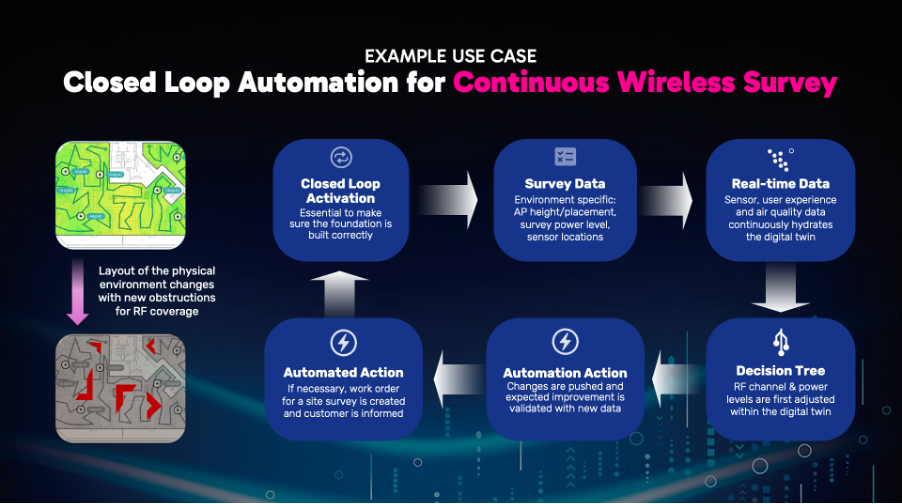Share Via
Introduction
RF channel planning for Wi-Fi deployments has been a key area of consideration to ensure a high performing enterprise Wireless LAN (WLAN) for decades. It all starts with a thorough RF site survey, usually conducted using popular purpose built tools. A floor map for the location is imported into the survey tool, that includes walls, shelves, cubes, and doors, as well as the RF attenuation value of these objects.
An active survey is then performed by mounting a Wi-Fi Access Point at the intended height and its signal is measured using an end device from various points on the floor. This active survey data helps capture the access point’s signal propagation as seen by the end device. In turn this data is used to identify the placement and number of access points required to provide coverage across the floor.
Many other manual tasks to follow. Here at Nile we have chosen to automate many aspects of this process with AI. If you would like to catch the demo before we dive deeper, here it is:
Considerations in traditional WLANs
Once the site survey is done within traditional WLAN designs, the next step is to deploy access points as per the plan. However, this process can be error prone as installers may place APs in the wrong location. After the placement and activation of APs, typically, a centralized channel planning and radio management software comes up with a channel and power allocation based on AP to AP visibility and neighborhood data.
This approach often lacks adding any closed loop input from the site survey data to the channel planning software. Things like the height of APs and power levels used during the site survey to ensure optimal coverage, which are key for starting with a robust baseline. This also eliminates the guesswork on what power levels to use. Thus, the automated channel optimization approach today is still in a silo.
Although channel planning algorithms have evolved and become very sophisticated, they still lack the input from an endpoint device’s perspective. There could be RF changes happening in the environment that AP to AP visibility alone may not be able to determine or detect. The question to ask is, was the RF site survey conducted to ensure optimal AP placement and coverage, and is that initial survey still valid down the road? Has or will the environment change over a period of time?
An initial site survey and the data
Because Nile is involved in every step of bringing up a Nile Access Service we used this to rethink how we could leverage AI and automation along every step; from a purchase order to the deployment of the APs and switches, to Day N optimization use cases. RF channel planning is a key component in ensuring performance guarantees built into our service.
As a first step, we ensure the foundation of our wireless network is built correctly using AI-enabled closed loop installation practices to weed out deviations at the time of install. We not only conduct a thorough site survey, but also ensure the deployment installer is guided per the specifications delivered through our mobile app. For more on our closed loop network design and installation capabilities.
The site specific survey data includes information about power levels used in the active and predictive survey to ensure coverage, which are fed into the channel planner along with data such as height of AP. This takes the guesswork out of determining power levels to use on the APs on Day 1.
Using the Digital Twin for continuous surveys
Once the Digital Twin for a Nile network installation is set up within the Nile Services Cloud, it is constantly hydrated by deep instrumented telemetry from our AP’s as well as the Nile sensors that represent the end user experience. The data from the sensors is key in ensuring that Cognitive Decisions powered by AI within the Nile Services Cloud are made accurately.
We want to ensure that the Cognitive Decisions module in the Nile Services Cloud is getting data regarding overlapping wireless networks from internal and external sources, and also data about Wi-Fi interference, noise levels, and the end user’s RF perspective. If the layout of the physical environment changes and alters the RF coverage; with the data we have, we’re able to run a decision tree and detect changes in the RF environment.
If the Cognitive Decision module infers a need for applying power changes to the access points, the Digital Twin is updated with the power changes to ensure coverage is restored. In parallel we automatically initiate a work-order for Nile’s customer success team to possibly set up a site survey again.

Conclusion
In summary, enabling predictable wireless performance is not just about mitigating coverage problems based on AP to AP visibility, but detecting widespread environmental and geographical changes, mitigating the situation and automatically adjusting access point properties without requiring manual intervention. Without the AI powered closed loop automation, these types of capabilities can never be performed with a legacy Wi-Fi network.
Nile customers get so much more via the Nile Access Service that goes beyond just channel planning. Our standardized deployment model, built in AI, and automation deliver a continuous RF site survey capability that detects environmental changes, ensuring a high level of on-going quality with performance guarantees.

